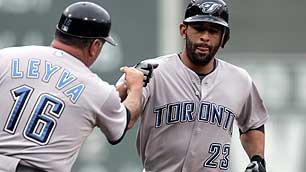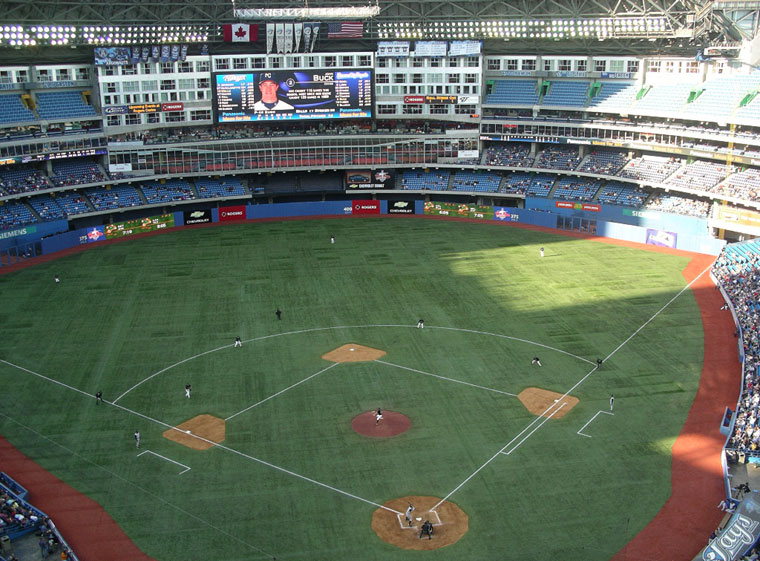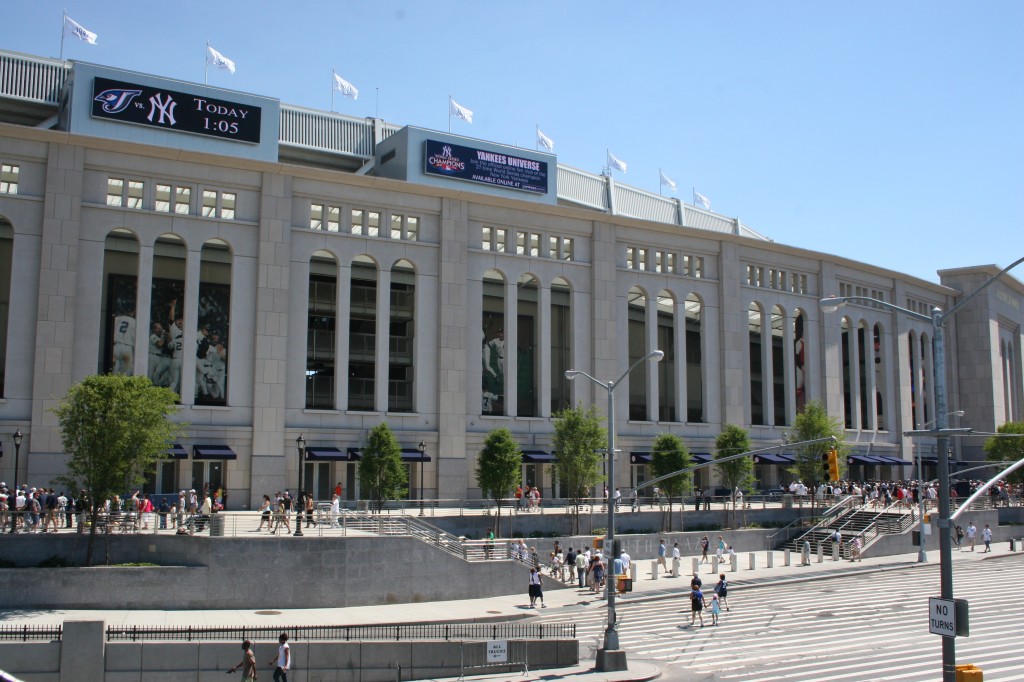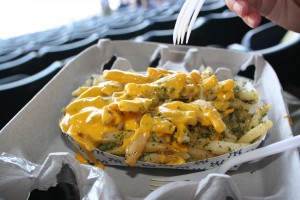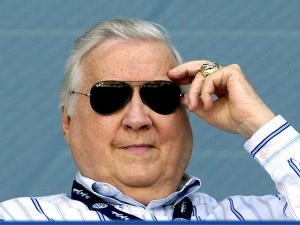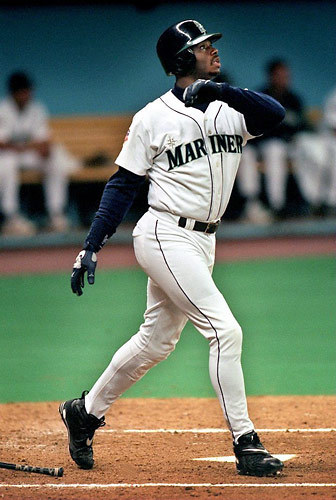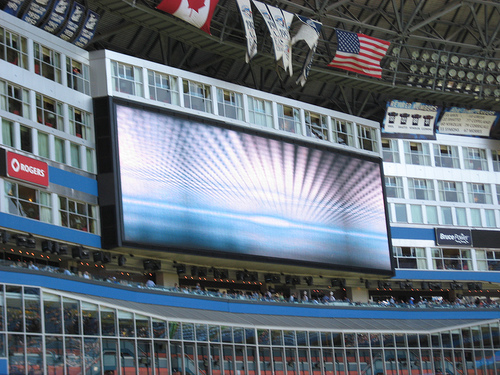My latest byline
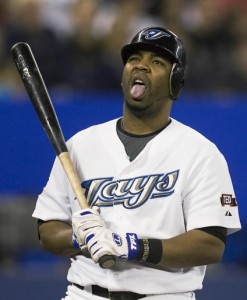 A big part of working desk shifts is listening in on conference calls with athletes, coaches and managers.
A big part of working desk shifts is listening in on conference calls with athletes, coaches and managers.
Today I sat in on a call with Toronto Blue Jays general manager Alex Anthopoulos. The team had set up the call after the Jays signed the club option for infielder Edwin Encarnacion and let relief pitcher Jon Rauch, amongst others, become free agents.
A link to my article is below.
Encarnacion to become utilityman for Jays
TORONTO - Edwin Encarnacion is going to be a jack of all trades for the Toronto Blue Jays next season.
General manager Alex Anthopoulos said Tuesday that the 28-year-old infielder is going to spend more time as a designated hitter and even play some games in the outfield.
"The fact that Edwin can play multiple positions, and now he's going to be playing some left field in winter ball as well, will open up some flexibility," Anthopoulos told a media conference call. "As we sit here today, the role would primarily be DH but we like he can play some first, play some third and we'd like to find out a little bit more about him in left field."
Book review – The Way of Baseball
As I've alluded to once or twice, I used to work for the World's Biggest Bookstore in downtown Toronto, a part of the Chapters-Indigo chain.
About the same time I moved on to being a professional writer many of my coworkers at the WBB also moved on to bigger and better things, including my manager Justin Sorbara-Hosker, who now works for Indigo's online department.
A couple of weeks ago Justin and the staff at Simon and Schuster were kind enough to forward me a copy of Shawn Green's new book "The Way of Baseball" which I reviewed for Indigo's blog.
Below is my introduction, followed by a link to the rest of the article.
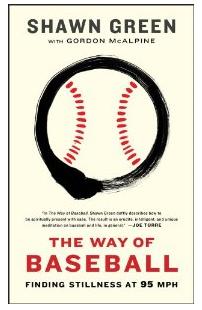 Shawn Green's The Way of Baseball has a concept so simple it's amazing no one has done it before—it uses hitting a baseball as an evolving metaphor that can be applied to everyday life.
Shawn Green's The Way of Baseball has a concept so simple it's amazing no one has done it before—it uses hitting a baseball as an evolving metaphor that can be applied to everyday life.
Green draws on his career as a right-fielder with the Toronto Blue Jays, Los Angeles Dodgers, Arizona Diamondbacks and New York Mets and examines how he used batting practice as a method of finding peace and balance in his day-to-day life.
The book is broken into nine chapters titled “Stillness,” “Space and Separation,” “Awareness,” “Ego,” “Presence,” “The Zone,” “Nonattachment,” “Gratitude,” and “Epilogue”. Each section details a step in Green’s personal journey as he develops stillness and awareness at the plate and in his interactions with teammates, coaches and fans.
Stadium Review: Rogers Centre
As regular readers of this blog know, I’ve been to several ballparks in this past year. Last summer I went to Detroit’s Comerica Park, while this July I went to New York City’s New Yankee Stadium and Citifield.
However, I had never considered reviewing the Rogers Centre, the ballpark in my hometown Toronto. Not because it’s unworthy, but because I was worried that I would be too hard on a stadium that has become a scapegoat for the attendance woes of the Toronto Blue Jays as well as the Canadian Football League’s Toronto Argonauts.
But on Tuesday night I returned to the former SkyDome after a month without attending a Jays home game and I realized, hey, this isn’t so bad.
First of all, I was buoyed by the recent ESPN study that found the Rogers Centre to be one of the cleanest stadiums in all of professional sports, a small club that includes the Air Canada Centre, home of the Toronto Maple Leafs and Toronto Raptors. There are only nine other venues that have spotless health records.
Also, after my 45 minute subway ride to Citifield in Queens, New York, I have found a new appreciation for the downtown location of the Rogers Centre. It’s a five minute walk through a dedicated passage from Union Station, giving the ballpark access to the Toronto Transit Commission and the provincial GO Trains.
The neighbourhood is ideal for out-of-towners hoping to kill some time before the opening pitch. Right beside the ballpark is the CN Tower, the second tallest structure in the world. Across the street is the Steam Whistle Brewery that serves one free sample beer to any visitor over the age of 19 and also has a variety of antique train engines.
Although it lacks the charm of the newer retro-styled parks like Citifield, Comerica and New Yankee Stadium, the Rogers Centre has all the same amenities with large and conveniently placed washrooms that are easier to find than the facilities at the American stadiums.
Of course, the former SkyDome’s big draw is its roof. Although it seems like a quaint 1980s concept, the retractable dome remains practical in a city that can have snow in April. The closed dome also means that the stadium is useful all year around.
Don’t get me wrong, there Rogers Centre does have its drawbacks, especially the feeling that it is always half-empty. It can’t be helped - its seating capacity is fifth largest in Major League Baseball but Toronto averages the fourth smallest crowd in the Majors. As a result, the stadium seems deserted for most games.
As far as service goes, the staff at concessions and in the stands are fine. However, the public announcer and the rest of the in-game entertainment seem desperate to energize the staid Toronto crowd. They don’t seem to realize that Torontonians are almost always quiet at concerts, festivals and other events. It’s just in the city’s character.
Unfortunately, this year they’ve tried to boost the crowd’s excitement by cranking the music as loudly as possible, stifling conversation and drowning out any attempts at chants or cheers from the crowd. The stadium may not be quiet, but the crowd is. It distracts from the action on the field and takes away from baseball’s pastoral roots.
Toronto’s Rogers Centre is far from perfect, but it’s also not the worst ballpark I’ve ever been to. It’s accessible by public transit and is reasonably priced. It’s clean and family friendly. Unlike Fenway Park or Yankee Stadium it’s better suited to locals than visiting fans, but that’s not a serious offence for a stadium. It serves the city of Toronto admirably.
Stadium Review: New Yankee Stadium
Visiting Yankee Stadium – the new one, that is – and watching the Pinstrippers host the Toronto Blue Jays was the focal point of my recent trip to the New York City. It was the fourth major league ballpark I’ve ever been to and easily the most awaited.
Opened in 2009, the so-called New Yankee Stadium was built across the street from the original Yankee Stadium. I had tried in vain to get tickets at the elder stadium before it was knocked down, but the only available tickets cost an arm and a leg through scalpers.
I missed out on the House that Ruth built, but did make it to the underwhelming House that Jeter built.
Don’t get me wrong, New Yankee Stadium has a lot going for it.
Architecturally, it’s beautiful. The ballpark stands as a monument to the impressive legacy of Old Yankee Stadium, mimicking many of the original field’s most distinctive qualities and emphasizing that this is the home of the most successful franchise in baseball history.
The architectural team of Populous insured that the dimensions of the field are exactly the same as the old park, although the new seating is slightly smaller the original field at 52,325 (including standing room) versus 56,936.
Also, as you can imagine, the New York Yankees know what they’re doing when staging a baseball game. Every little detail during the game was skilfully handled, from the anthems to the TV timeout features.
Charming touches abounded, especially when the Yankees’ current roster recited Lou Gehrig’s famous speech to commemorate the anniversary of his final game with the club.
And the food, my God, the food. Every stadium has a signature dish. Something that is distinctly theirs. At Yankee Stadium it’s garlic French fries with melted cheese. It’s gooey, salty, cheesey and above all else potent enough to guarantee some space on the subway ride home.
Populous did a lot to emphasize the history of baseball in New York City including moving Monument Park from the older building, creating a Yankee Museum and, of course, a centralized merchandise store off the stadium’s main concourse.
But that’s one of the key problems with New Yankee Stadium.
In their slavish devotion to replicating the style and design of the older building, they did little to improve on the old stadium. Yes, everything is new and shiny but facilities are few and far between.
As a result, there are long lines just about every step of the way. Crowds arrive early, so there is a long wait for most of the features of the park, especially Monument Park, the Yankee Museum and the merchandise outlet.
In fact, the line for Monument Park was cut off an hour and a half before the opening pitch because security personnel needed to be able to clear it out before game time. Same thing with the Yankee Museum – lines had to be cut off because they were so long.
I’ll allow that I went on Independence Day, when most of the crowd was probably from out of town and therefore more likely to go to the touristy corners of the stadium, but surely they could have predicted that those would be crowded sections of the stadium.
Instead, the entrance to Monument Park is in the middle of a cramped corridor. Compared to other contemporary stadiums like cross-town rival Citifield or Detroit’s Comerica Park, which put an emphasis on wide-open space and breezy walkways, it’s a confusing choice.
Ultimately, it’s worth going to Yankee Stadium to say “I’ve been there.” Visitors should expect high prices, long lines and cramped quarters. I would not want to be a Yankees fan and have to attend more than one game per season at that ballpark.
Book Review: Bullpen Gospels by Dirk Hayhurst
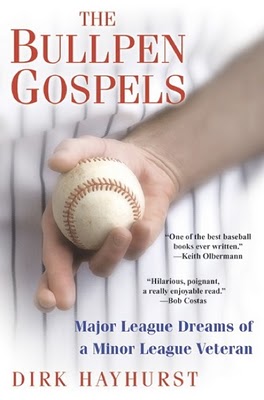 Halfway through Dirk Hayhurst’s Bullpen Gospels it occurred to me that I was reading one of the best books on baseball, ever.
Halfway through Dirk Hayhurst’s Bullpen Gospels it occurred to me that I was reading one of the best books on baseball, ever.
That’s some strong talk, particularly for someone who hasn’t read the entire baseball canon. But I’m getting there - just about every other book I read is about baseball.
I’ve devoured Jim Bouton’s Ball Four more than five times, I loved John Feinstein’s Living on the Black and Michael Lewis’ Moneyball. Also, as fans of this blog know, I’ve reviewed the graphic novel Satchel Paige:Striking Out Jim Crow as well as Sports Illustrated’s Great Baseball Writing.
The Bullpen Gospels slot in right above all of those, including Ball Four, my previous titleholder.
They’re comparable books too. Both are written by professional baseball players who find themselves pitching long relief in a bullpen full of odd characters. Yes, Bouton was an established major leaguer trying to master the knuckleball while Hayhurst, at that point, was a career minor leaguer in the San Diego Padres organization, but they’re still pretty similar books.
Bouton’s book is infamous for exposing the real lives of baseball heroes like Carl Yastrzemski and Mickey Mantle at a time when they were idolized by most fans. The aging Seattle Pilots reliever took a lot of heat for the book, with many people saying Bouton was a gloryhound. I don’t agree with that sentiment, but it certainly reads like an expose.
Love it or hate it, Ball Four is a hilarious and insightful read. But, by contrast, the Bullpen Gospels is a much more genuine and sensitive story.
Starting with Hayhurst’s truly dire home life with an unbalanced grandmother and a fractured family crippled not by one, but two, alcoholics you immediately feel for the young reliever. When he moves on to spring training and the minor leagues you can’t help but appreciate his sense of humour.
Perhaps the most noticeable difference between Hayhurst and Bouton is that the former rarely criticizes his teammates or the Padres’ executives. On the few occasions when he does speak poorly of someone, it is a reasonable and measured critique, and he shies away from dropping big names for the sake of glamour.
The only person Hayhurst is really hard on is himself.
Gospels is a quick read that makes its way through an entire baseball season, with a truly joyous ending. It also imparts a better understanding of what life in the minors is like for aspiring ballplayers. Hayhurst is an effortless and charming writer. He’s likeable and always sincere in his beliefs.
I’d recommend this book to anyone, particularly as a companion to Jim Bouton’s Ball Four.
George Steinbrenner will be missed
Earlier today the Associated Press reported that George Steinbrenner, the long-time owner of the New York Yankees, died at the age of 80 after suffering a massive heart attack.
Steinbrenner’s passing was confirmed by the Yankees organization, as well as his family who issued a statement.
“He was an incredible and charitable man,” the Steinbrenners said in their release. “He was a visionary and a giant in the world of sports. He took a great but struggling franchise and turned it into a champion again.”
I wholeheartedly agree with those sentiments. George Steinbrenner was the best owner in baseball, and arguably, in all of professional sports.
Consider the Yankees without the seven World Series championships (2009, 2000, 1999, 1998, 1996, 1978, 1977) they won under his direction. It’s hard to do.
That means no Mr. October, Reggie Jackson.
Derek Jeter, Mariano Rivera, Andy Pettite and Jorge Posada wouldn’t have been the Core Four of the dynasty of the late 1990s and early 2000s.
The New York Yankees, the Evil Empire as we know it, would not have existed without the leadership of the Boss.
Now some may argue that Steinbrenner’s influence damaged the game. As a season ticket holder of the Toronto Blue Jays, I can sympathize. The war of attrition with the Boston Red Sox in the American League East with both teams stockpiling arms like Cold War superpowers has basically ruined any chance of my hometown team winning a pennant.
But that’s a situation that can’t be entirely blamed on Steinbrenner. Major League Baseball made the luxury tax rules, he merely played within their bounds. I can’t say that I blame him. Any owner – any person, for that matter – should pursue success to the fullest extent of their resources.
There’s no point in hating Steinbrenner simply because he had more resources than everyone else.
I’m sure that one of my colleagues in the media is going to write a similar eulogy about how Steinbrenner is the last of a dying breed. How we’ll never see another person make such an impact as the owner of a professional sports team.
Although George Steinbrenner was a unique character, there will be more owners like him. Already in the National Basketball Association we have Mark Cuban and Mikhail Prokhorov, the owners of the Dallas Mavericks and New Jersey Nets respectively, both cast very much in the Steinbrenner mould.
No, I think that Steinbrenner serves as the prototype of what the owner of a professional sports team can be. An ideal example that other owners should model themselves after. He was one of the greats, and although his New York Yankees are often hated, his is a legacy that should be admired.
A fond farewell to Ken Griffey Jr.
Last night was one of those perfect storms of sports news that happens every month or so.
Armando Galarraga’s perfect game was ruined on the 27th out by a controversial call by umpire Jim Joyce.
Game 3 of the Stanley Cup final went into overtime, with a goal being called back after the puck miraculously rolled across the crease. The no-goal was after National Hockey League Commissioner Gary Bettman got cantankerous with Ron MacLean during the second intermission of Hockey Night in Canada.
But what I’ll always remember about June 2nd 2010 is that Ken Griffey Jr. retired.
As I’ve written before, Griffey was my favourite baseball player growing up.
In his prime he was the best fielder and hitter in the game. In a time when professional athletes develop chips on their shoulders, become arrogant or act out, Griffey remained fun-loving and grounded.
His statistics speak for themselves. Griffey accumulated 630 home runs, the fifth-most in baseball history. He has 2781 hits, 1836 RBIs and a career batting average of .284. Hall of Fame numbers to be sure.
Griffey’s best season was undoubtedly 1997 when he won the American League MVP with the Seattle Mariners. That year he hit .304 while reaching career highs with 56 home runs and 147 RBIs.
As impressive as his numbers are, Griffey will always have the aura of unfulfilled potential. Not because he lacked effort, but because he never played in a World Series, even though his Seattle Mariners had a host of talent including Alex Rodriguez, Randy Johnson and Edgar Martinez.
Because he moved to the Cincinnati Reds, a team that has struggled throughout the 1990s and 2000s, he missed out on further playoff opportunities, including two more American League Championship appearances by Seattle in 2000 and 2001.
Nagging injuries forced Griffey to miss prime years of his career. Between 2002 and 2004 he hit a total 41 home runs while playing in only 206 games over those three seasons.
Although Griffey was great, arguably the best of an entire generation of ballplayers, it will always seem as though he might have had still had some untapped potential.
Despite those lost years, Griffey’s career represents an ideal trajectory that in a perfect world all athletes would follow.
Griffey was a genuinely good guy. Griffey knew he was going to be traded from Seattle in 2000, so he asked to be sent to his hometown Cincinnati Reds, the team his father played for in their Big Red Machine glory days. Given the opportunity to abandon the Reds in favour of a bigger salary with the New York Yankees, Griffey took a smaller contract to stay near his family.
He can also be judged for what he didn’t do. In an era where players like Mark McGwire are being held out of Baseball’s Hall of Fame for their connection to performance enhancing drugs, Griffey remains a first-ballot shoe-in because he’s never been connected to any kind of steroid use.
Although Griffey was a shadow of his former self in his final years with the Reds, Chicago White Sox and again with the Mariners, his legacy on and off the field is exemplary of what all baseball players could be – a role model off the field who actually produces incredible numbers.
Griffey will be missed as player, but he will always have a place in baseball.
Floyd Mayweather has the right idea
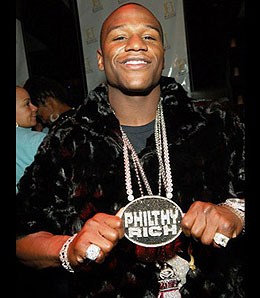 Earlier today it was announced that boxing superstar and WBO champion Manny Pacquiao has agreed to WBC champion Floyd Mayweather’s demands and will submit to random drug screening as part of a deal to make a dream welterweight match happen.
Earlier today it was announced that boxing superstar and WBO champion Manny Pacquiao has agreed to WBC champion Floyd Mayweather’s demands and will submit to random drug screening as part of a deal to make a dream welterweight match happen.
“As long as they’re not getting a large amount of blood, I am willing to give out blood as close to two weeks before the fight,” Pacquiao told the Bulletin late Wednesday night.
This is the second time the two pugilists have agreed to fight; their first encounter was cancelled when Pacquiao refused to be tested for performance enhancing drugs, a procedure that Mayweather insists that he and all of his opponents go through.
Whoever wins this match will be considered the best pound-for-pound boxer in the world. It promises to be an exciting pairing, one that fans of the sweet science have been clamouring for for years.
Some corners feel that this was simply an excuse for Mayweather to duck the seemingly superior Pacquiao. That the drug tests are a stalling tactic by Mayweather to protect his perfect record.
I’m not sure that this is the case. I hope not, because I think that Mayweather has the right idea.
With so many athletes in so many sports testing positive for steroids, human growth hormone or even recreational drugs, many fans are becoming increasingly cynical. Steroid scandals have dealt body blows to the reputations of baseball, cycling and the Olympics.
By voluntarily submitting blood samples to the United States Anti-Doping Agency Mayweather is not just protecting his legacy, but improving the tarnished image of sports.
It’s a breath of fresh air, and particularly refreshing given the sorry state that boxing is in. The sweet science is losing ground to mixed martial arts by the day. This is a sport that has too many titles, too many flashes in the pan.
But Mayweather’s aggressive pro-testing stance means that boxing’s dwindling number of fans, whether they like him or not, at least know that there is some integrity whenever he steps in the ring.
Personally, if I were a professional athlete in any other sport I would be doing the same thing. By getting voluntarily tested on a monthly basis for the duration of my career, there would be no doubt about the veracity of my records.
This is especially topical since disgraced Tour de France winner Floyd Landis revealed to his sponsors today that he has been doping since 2002.
If I were another professional cyclist I would want to guarantee that everyone knew that I was clean, no matter how well I did. A sure-fire way to do that would be to hold myself to an even higher standard than that of by sports’ governing body.
Although the North American legal system relies on burden of proof – that everyone is innocent until proven guilty – this isn’t about laws. This is about regaining the public’s trust and establishing a reputation of integrity. In that respect, Floyd Mayweather is doing the right thing.
An open letter to the Toronto Blue Jays
As I’ve mentioned previously, I’ve got a season’s pass for the 500 section of the Rogers Centre for all of the Toronto Blue Jays home games.
This is the fifth season that I’ve had the pass and it’s always a good purchase. The last two years have been particularly enjoyable since the Jays have been very good, particularly in the spring.
However, there’s a problem that creeps up every few games which bugs me. It happened at the last two games I attended and, frankly, I am fed up. So this morning I sent the following email to the Blue Jays:
Dear Blue Jays/Rogers Centre Staff,
I've been a Toronto Star Seasons Pass holder for the past five seasons. I enjoy going to the games and cheering on the Blue Jays.
However, I'm frustrated with my experience at the Rogers Centre and the lack of instant replay on close calls.
This was underscored by the games on Sunday, May 16 and Monday, May 17.
On Sunday John Buck hit a long ball that, from my vantage point in the 500s, looked like a grand slam. However, it was called a ground rule double.
To the umpires’ credit, they went into the dugout to review the play.
Unfortunately, due to the Rogers Centre policy of never showing a close call on the JumboTron, I couldn't see whether or not the officials were making the right call. I was robbed of the chance to judge for myself. I only learned that the umpires had made the correct call when I got home and saw the highlights on TV.
Similarly, at Monday's game, a close call was not shown on the JumboTron.
Lyle Overbay bobbled a throw from Jose Bautista, earning an error. He then threw the ball to third, which sailed past Bautista, earning another error.
Again, thanks to the Blue Jays' short-sighted policy of not showing close calls, I never saw that Overbay had mishandled Bautista's throw.
Instead, I had to rely on this morning's SportsCentre to learn that the umpires had, in fact, made the right call.
These are not the only examples of this frustrating policy, they're just the most recent.
It would do a lot to improve your organization's in-stadium product if you would stop protecting your players and the umpires from the occasional round of heckles.
Please start showing replays of all plays - even if they're close or controversial - because it greatly increases the enjoyment of the game for your audience.
Sincerely,
John
I’ve discussed it with some of my friends and co-workers and have learned that the policy is a passive directive from Major League Baseball’s head office.
The Toronto Star’s Richard Griffin summed it up last Wednesday:
“It is in fact a recommendation from Major League Baseball that teams not show a) close ball-strike replays; b) close plays that may incite the crowd against umpires; and c) plays that are under review i.e. home run calls. Now not every team abides by that rule, although all do on balls and strikes, but the Jays are good, responsible corporate citizens and do not show close calls on the replay board. I disagree because why should fans sitting at home know more about the game than those in the ballpark?”
Obviously, I agree with Griffin’s sentiments.
I would add an important note: In both cases this weekend the umpires had made the correct call. It was close, but they were spot on. Therefore, an instant replay wouldn’t incite the crowd against umpires.
Yes, as a Toronto fan I would have booed because I was frustrated with Overbay’s errors, but I would not have felt any anger toward the umpire for making the right call.
Further, Buck’s ground rule double wouldn’t have caused me to boo at all. He still batted in some runs and gave the Jays the lead. Not as good as a grand slam, but ultimately, there’s nothing to boo there.
If the officials are making objective and correct calls, then the commissioner’s office should have enough confidence to include their fans in what’s happening on the field.
No good can come from leaving your fan base ignorant of what’s going on in the course of a game and MLB as well as its franchises should adjust this rule.
In particular, the Rogers Centre has a beautiful JumboTron that should be put to good use. The Blue Jays should be able to trust their sedate Toronto supporters to not freak out over a controversial call.
